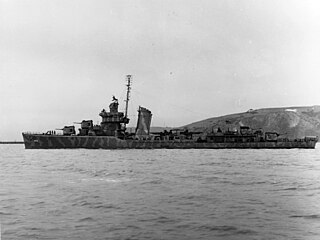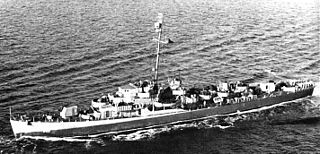
USS Underhill (DE-682) was a Buckley-class destroyer escort of the United States Navy during World War II. Built in 1943, she served in the Atlantic, the Mediterranean, and the Pacific until her sinking in a suicide attack by a Japanese Kaiten manned torpedo on 24 July 1945.

USS Abercrombie (DE-343) was a John C. Butler-class destroyer escort in the service of the United States Navy from 1944 to 1946. She was finally sunk as a target in 1968.

USS Hughes (DD-410) was a World War II-era Sims-class destroyer in the service of the United States Navy.

USS Jobb (DE-707) was a Rudderow-class destroyer escort in service with the United States Navy from 1944 to 1946. She was sold for scrap in 1970.

USS Weeden (DE-797) was a Buckley-class destroyer escort in service with the United States Navy from 1944 to 1946 and from 1950 to 1958. She was scrapped in 1969.

USS Hopping (DE-155) was a Buckley-class destroyer escort in service with the United States Navy from 1943 to 1947. In 1944, she was converted to a Charles Lawrence-class high speed transport and redesignated "APD-51". She was sold for scrap in 1966.

USS Lloyd (DE-209/APD-63), a Buckley-class destroyer escort of the United States Navy, was named in honor of Ensign William R. Lloyd (1916–1942).

USS Major (DE-796) was a Buckley-class destroyer escort in service with the United States Navy from 1944 to 1948. She was scrapped in 1973.

USS Griswold (DE-7) was an Evarts-class short-hull destroyer escort in the service of the United States Navy, named for Ensign Don T. Griswold, who perished during the Battle of Midway 1942.

USS Gentry (DE-349) was a John C. Butler-class destroyer escort acquired by the U.S. Navy during World War II. The primary purpose of the destroyer escort was to escort and protect ships in convoy, in addition to other tasks as assigned, such as patrol or radar picket.

USS Jaccard (DE-355) was a John C. Butler-class destroyer escort acquired by the U.S. Navy during World War II. The primary purpose of the destroyer escort was to escort and protect ships in convoy, in addition to other tasks as assigned, such as patrol or radar picket. Post-war, she returned home with one battle star to her credit.

USS Woodson (DE-359) was a John C. Butler-class destroyer escort acquired by the United States Navy during World War II. The primary purpose of the destroyer escort was to escort and protect ships in convoy, in addition to other tasks as assigned, such as patrol or radar picket.
USS Johnnie Hutchins (DE-360) was a John C. Butler-class destroyer escort acquired by the U.S. Navy during World War II. The primary purpose of the destroyer escort was to escort and protect ships in convoy, in addition to other tasks as assigned, such as patrol or radar picket. She served in the Pacific Ocean, and, post-war, she returned home with a Navy Unit Commendation awarded to her for her battle with Japanese midget submarines on 9 August 1945.

USS Richard S. Bull (DE-402) was a John C. Butler-class destroyer escort in service with the United States Navy from 1944 to 1946. She was finally sunk as a target in 1969.

USS Ringness (APD-100) was a Crosley-class high speed transport that served in the United States Navy from 1944 to 1946. After spending 29 years in reserve, she was sold for scrapping in 1975.

USS Leslie L. B. Knox (DE-580) was a Rudderow-class destroyer escort in service with the United States Navy from 1944 to 1946. She was scrapped in 1973.

USS Peiffer (DE-588) was a Rudderow-class destroyer escort in service with the United States Navy from 1944 to 1946. She was sold for scrapping in 1967.

USS Brock (APD-93), ex-DE-234, was a United States Navy high-speed transport in commission from 1945 to 1947.

USS John Q. Roberts (APD-94), ex-DE-235, was a United States Navy high-speed transport in commission from 1945 to 1946.
The second I-53 was the second of three Type C cruiser submarines of the C3 sub-class built for the Imperial Japanese Navy. Commissioned in February 1944, she operated primarily as a kaiten manned suicide attack torpedo carrier during the final year of World War II and sank the destroyer escort USS Underhill (DE-682). Surrendered at the end of the war, she was scuttled by the United States Navy in 1946.


















